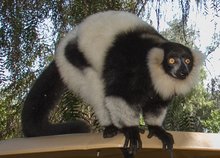Olivia Black and White Ruffed Lemur
IUCN: Critically Endangered

As the most threatened group of mammals on earth, 95% of lemur species are on the brink of extinction. Black and white ruffed lemurs (Varecia variegata), along with red-ruffed lemurs, are the largest lemur species.
Significant deforestation in Madagascar has meant that all 111 species of lemurs' already geographically limited native habitat is largely disappearing. As such, the need for preserving Olivia and other lemurs' native habitat is urgent. Conservation efforts are also focused on addressing a recent rise in lemur hunting.
The ruffed lemur is mostly arboreal, very agile, and the only lemur that builds a nest padded with hair from the female, for what are usually twins or triplets. They live in groups of 5-15 individuals that are led by females who aggressively defend their territories. Black and white ruffed lemurs have a wide range of vocalizations and are very communicative with each other—and with intruders!
Fun Fact: Black and white ruffed lemurs are known as the world's largest pollinators. They are mainly frugivores (fruit-eaters) and have a mutualistic relationship with the traveler's tree (Ravenala madagascariensis), also known as the traveler's palm. The lemurs' specialized snout allows them to access the tree's nectar while pollen sticks to their fur, which they then carry off to the next tree they drink from.
Significant deforestation in Madagascar has meant that all 111 species of lemurs' already geographically limited native habitat is largely disappearing. As such, the need for preserving Olivia and other lemurs' native habitat is urgent. Conservation efforts are also focused on addressing a recent rise in lemur hunting.
The ruffed lemur is mostly arboreal, very agile, and the only lemur that builds a nest padded with hair from the female, for what are usually twins or triplets. They live in groups of 5-15 individuals that are led by females who aggressively defend their territories. Black and white ruffed lemurs have a wide range of vocalizations and are very communicative with each other—and with intruders!
Fun Fact: Black and white ruffed lemurs are known as the world's largest pollinators. They are mainly frugivores (fruit-eaters) and have a mutualistic relationship with the traveler's tree (Ravenala madagascariensis), also known as the traveler's palm. The lemurs' specialized snout allows them to access the tree's nectar while pollen sticks to their fur, which they then carry off to the next tree they drink from.
